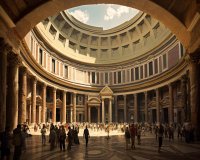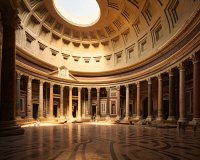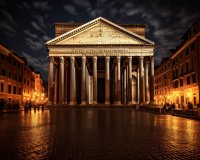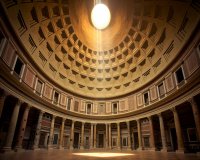The Historical Significance of the Pantheon in Roman Culture
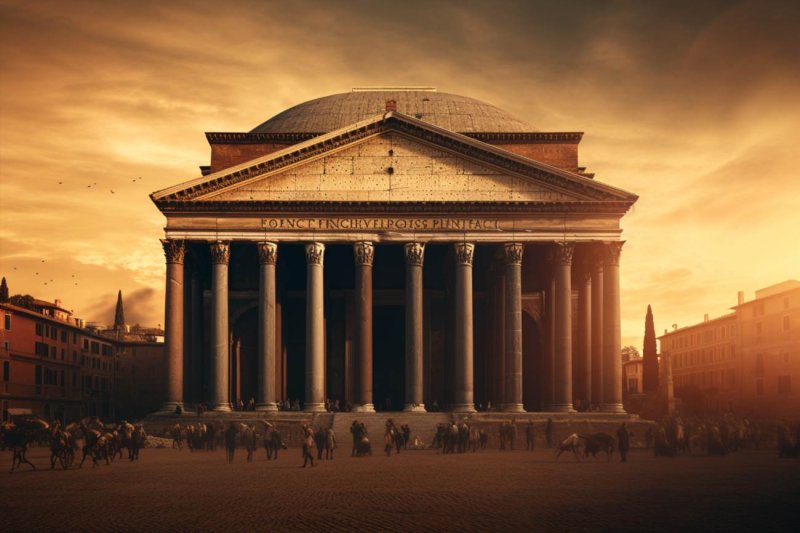
The Historical Significance of the Pantheon in Roman Culture
The Pantheon, one of the most iconic structures in Rome, holds a special place in the annals of Roman history and culture. Built nearly two millennia ago, this architectural marvel stands as a testament to the ingenuity of Roman engineering and the enduring influence of Roman culture. Let's delve into the historical significance of the Pantheon in the context of ancient Rome.
The Pantheon, whose name is derived from the Greek words "pan" (meaning "all") and "theos" (meaning "gods"), was originally constructed by Marcus Agrippa in 27 BC. However, the present structure that we see today is primarily the result of Emperor Hadrian's renovations around 126 AD.
Architectural Marvel
One of the most remarkable features of the Pantheon is its iconic dome. This dome, with its impressive 142-foot diameter, was the largest of its kind in the world for centuries. The use of concrete in its construction allowed the Romans to create a massive, self-supporting structure, and the oculus, or the open central circle, served both as a source of natural light and as a connection to the divine.
The architectural brilliance of the Pantheon has inspired countless architects and builders throughout history. It remains a symbol of the Romans' advanced understanding of engineering and construction techniques. Even today, architects and historians marvel at the Pantheon's enduring structural integrity.
Religious Significance
The Pantheon's original purpose was as a temple dedicated to all the Roman gods and goddesses. It was a place of worship and a symbol of the religious pluralism of the Roman Empire. The design of the dome allowed for a sense of openness and connection to the heavens, reinforcing the belief that the gods were watching over the people of Rome.
With the rise of Christianity in the later Roman Empire, the Pantheon was converted into a Christian church, and it became known as the Church of St. Mary and the Martyrs. This transformation speaks to the adaptability of Roman culture and its ability to incorporate new belief systems into existing structures.
Cultural and Artistic Influence
The Pantheon's impact on Roman art and culture is immeasurable. The dome's design, with its perfect proportions and harmonious aesthetics, served as a model for countless Roman buildings. Its influence can be seen in the architecture of temples, basilicas, and public buildings throughout the Roman Empire.
The Pantheon also played a role in shaping the Renaissance period, with architects like Brunelleschi drawing inspiration from its design. This architectural gem continues to influence artists, architects, and designers to this day, underscoring its timeless appeal.
Modern-Day Significance
Today, the Pantheon stands as a remarkable blend of ancient history and contemporary culture. It attracts millions of tourists each year who come to marvel at its architectural grandeur and explore its rich history. It's also a symbol of Rome's enduring legacy as a city that seamlessly bridges the past and the present.
In 1980, the Pantheon was designated as a UNESCO World Heritage Site, recognizing its global importance as a cultural and historical treasure. This status ensures its preservation for future generations and cements its place as an iconic symbol of Roman culture and innovation.
In conclusion, the Pantheon's historical significance in Roman culture is profound. As an architectural marvel, a place of worship, and a source of inspiration, it continues to stand as a testament to the enduring legacy of the Roman Empire and the remarkable contributions of Roman civilization to the world.
Rome Sunset Tour: Spanish Steps, Trevi Fountain, Navona & Pantheon
Embark on a captivating 2-hour walking tour through the heart of Rome as the sun sets, revealing the ancient monuments in all their illuminated splendor. Join our licensed, English-speaking guide, Ruggero, in Piazza di Spagna, where history comes alive with a narration of the Spanish Steps and the iconic Fontana di Trevi, where a single coin promises your return to Rome.
Witness the majestic exterior of the Pantheon before strolling through charming streets to reach the enchanting Piazza Navona. Marvel at the baroque Fountain of the Four Rivers, a masterpiece by Gian Lorenzo Bernini. This semi-private experience, limited to 10 participants, ensures an intimate and personalized sightseeing adventure.
Highlights:
- Explore Rome’s top attractions: Spanish Steps, Trevi Fountain, Pantheon, and Piazza Navona.
- Engage in a 2-hour guided walking tour with a top-rated, licensed English-speaking guide.
- Enjoy a semi-private experience with a group limited to 10 people.
Uncover the magic of Rome as it lights up at sunset, and immerse yourself in the rich history and beauty of these iconic landmarks. Ruggero will meet you in Piazza di San Simeone, next to the fountain, to commence this unforgettable journey through the Eternal City.
Includes:
- 2-hour walking tour covering Rome’s top attractions.
- Licensed and top-rated English-speaking guide.
Reserve your spot now, pay later, and experience the allure of Rome with this unique and limited tour!
Customer Reviews
Overall Rating: 5/5 based on 8 reviews
Recent Reviews:
“Really informative with a knowledgeable guide who offered a little humor where needed.” - Pete, United Kingdom
Join satisfied travelers from Germany and Canada who found this tour both helpful and enlightening. Book your spot today and be part of the unforgettable journey through the historic gems of Rome!
Architecture and Details of the Pantheon, Rome
The Pantheon in Rome stands as a testament to the architectural genius of the ancient Romans. This remarkable structure, dedicated to all gods, has withstood the test of time, enduring over two millennia. Its design, engineering, and intricate details continue to inspire architects and historians alike.
The Pantheon was commissioned by Marcus Agrippa during the reign of Augustus in 27 BC, but the current building is believed to have been constructed by Emperor Hadrian around 126 AD, after the original structure was destroyed by fire.
Architectural Marvel
The Pantheon's architecture is characterized by its iconic dome, which remains the largest unreinforced concrete dome in the world. The dome's design is a perfect hemisphere, with a diameter of 43.3 meters (142 feet), matching the height from the floor to the top of the dome. This remarkable symmetry imparts a sense of grandeur and harmony to the structure.
One of the most intriguing aspects of the Pantheon's architecture is its oculus, a circular opening at the apex of the dome. This oculus serves both functional and symbolic purposes. It allows natural light to flood the interior, creating a dramatic interplay of light and shadow throughout the day. Additionally, the oculus is a metaphorical representation of the connection between the earthly realm and the divine.
Structural Innovation
The construction of the Pantheon is a testament to Roman engineering prowess. The dome's inner shell is composed of concrete mixed with volcanic ash, known as pozzolana, which provided remarkable strength and durability. The concrete becomes lighter and stronger as it ages, a property that has contributed to the Pantheon's enduring stability.
Surrounding the dome, the rotunda features walls of staggering thickness, which taper towards the top, reducing the overall load. The base of the rotunda, on the other hand, is supported by a series of Corinthian columns, each carved from a single block of Egyptian granite. These columns not only serve a structural purpose but also add a touch of elegance to the interior.
Intricate Details
Upon entering the Pantheon, visitors are struck by the meticulous attention to detail in its design. The floor is adorned with a stunning pattern of colored marbles arranged in concentric circles, leading the eye towards the center of the rotunda.
The coffered ceiling of the portico is another marvel of craftsmanship. It features a grid of sunken panels, each adorned with a rosette. These coffered indentations serve both aesthetic and structural purposes, reducing the weight of the dome while creating a stunning visual effect.
Legacy and Influence
The Pantheon's architectural innovations have left an indelible mark on subsequent generations of builders. Architects from the Renaissance onwards, such as Brunelleschi and Michelangelo, drew inspiration from the Pantheon's dome, influencing the design of countless churches and buildings throughout Europe.
Today, the Pantheon stands as a living testament to the enduring brilliance of Roman engineering and design. Its awe-inspiring architecture and intricate details continue to captivate visitors, making it a must-see landmark for anyone with an appreciation for architectural marvels.
Pantheon Guided Tour
Discover the wonders of the Pantheon with a knowledgeable local guide on this guided tour. Marvel at the Pantheon's awe-inspiring oculus and pay homage at Rafaelo's tomb. Delve into the history of Ancient Rome, learn about the artistic genius of Michelangelo, and more as your guide unravels the city's past.
About this Activity:
Embark on a journey through the ages with our expert guide, uncovering the artistry of Michelangelo and his portrayal of Christ on the cross. Explore the Basilica of Neptune and the remnants of thermal baths. Witness the original Roman street level, flood marks, and marble freezes, gaining unique insights into Rome's historical layers.
Your adventure continues as you step inside the Pantheon, a marvel of ancient architecture, to witness the breathtaking oculus and pay respects at Rafaelo’s tomb. Throughout this exploration, your guide will share fascinating information, allowing you to absorb the essence of three of Rome's top-ten attractions.
Highlights:
- Engage in an intimate small-group tour experience.
- Discover three of Rome's top 10 attractions.
- Gain profound insights into Ancient Rome's history from your expert local guide.
Meeting Point
Meet your guide at "L'Antica Salumeria" shop, situated in Piazza della Rotonda 4.
Important Information:
- Dress respectfully for the Pantheon, covering shoulders and knees as it is a sacred site.
- Ensure comfort with appropriate footwear for the tour.
Price: From €37 per person
Availability: Check available dates and times.
Check Availability
Overall Customer Rating: 4.6/5 based on 190 reviews
Review Summary:
Guide: 4.8/5
Value for money: 4.4/5
Service: 5/5
Organization: 5/5
Customer Reviews:
"Job was an awesome guide - engaging and entertaining. He provided interesting information in a light-hearted way as we explored the Pantheon. We loved the site and learned a lot. His tips for the perfect selfie were on point! Highly recommend!" - June 24, 2023, Lucianne from Australia
"Excellent tour. Our guide, Job, was very informative and entertaining, striking the right balance of information and fun. The Pantheon itself is a fantastic structure, richly decorated inside with its vast dome and oculus. A true wonder of ancient architectural engineering." - September 27, 2022, Ben from the United Kingdom
The Religious and Cultural Importance of the Pantheon in Rome
The Pantheon in Rome, with its stunning architecture and rich history, holds significant religious and cultural importance. This ancient temple has fascinated visitors for centuries and continues to be a symbol of Rome's enduring legacy.
Historical Significance
Originally built by Marcus Agrippa in 27 BC, the Pantheon has undergone several renovations and transformations. However, its enduring structure, characterized by a massive dome, remains an architectural marvel and a testament to Roman engineering prowess. The temple was dedicated to all the gods of ancient Rome, and this dedication is reflected in its name, which literally means "temple of all gods."
Throughout its history, the Pantheon has served various purposes, from a place of worship to a mausoleum. Most notably, it has played a central role in the development of Roman religion and culture.
Religious Significance
In its early days, the Pantheon was used for the veneration of Roman gods. The dome, with its oculus (an opening at the top), allowed sunlight to stream in and illuminate the temple's interior. This natural light was believed to symbolize the presence of the gods, making the Pantheon a sacred space for religious ceremonies and offerings.
The temple's association with Roman gods, such as Jupiter, Mars, and Venus, ensured that it played a vital role in the religious life of ancient Rome. Pilgrims and devotees from all corners of the empire would visit the Pantheon to pay homage to their deities and seek blessings.
With the rise of Christianity in the Roman Empire, the Pantheon's role shifted. In 609 AD, it was consecrated as a Christian church, known as the Church of Santa Maria ad Martyres. This conversion preserved the Pantheon's architectural magnificence while repurposing it for Christian worship. Today, it remains a functional church, attracting both tourists and worshippers.
Cultural Significance
The Pantheon's influence extends beyond religion. It has had a profound impact on architecture and art throughout history. The dome of the Pantheon, considered a masterpiece of ancient engineering, has served as an inspiration for countless architects and builders. Its innovative design has been replicated in various structures worldwide, including the United States Capitol in Washington, D.C.
Artists and writers have also been captivated by the Pantheon's grandeur. It has featured in numerous works of art, literature, and cinema, symbolizing the eternal city of Rome. The Pantheon's presence in popular culture further cements its cultural importance.
Conclusion
The Pantheon in Rome is a remarkable testament to the enduring legacy of the Roman Empire. Its religious and cultural importance spans millennia, making it a symbol of the rich history and heritage of Rome. Whether you visit for religious reasons, to admire its architecture, or to explore its cultural significance, the Pantheon continues to leave an indelible mark on all who experience its splendor.



